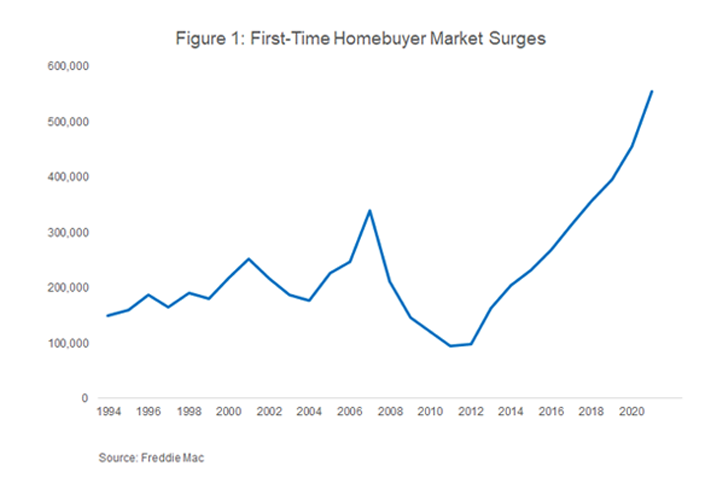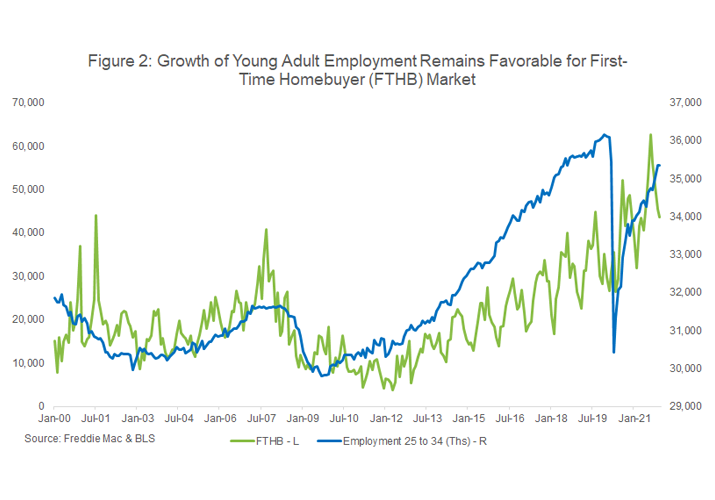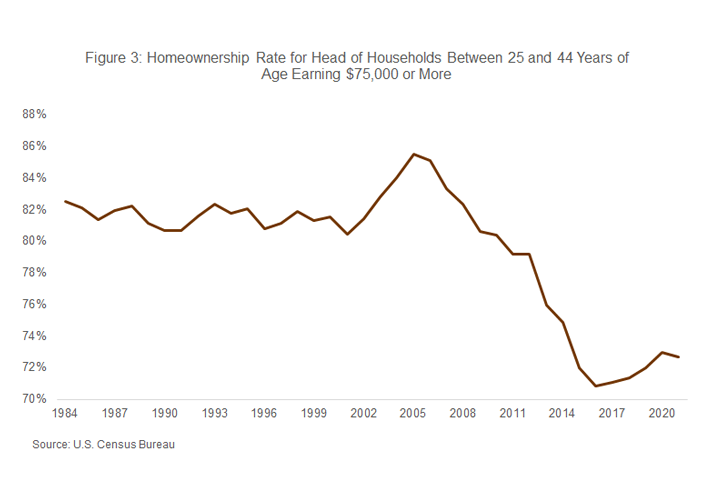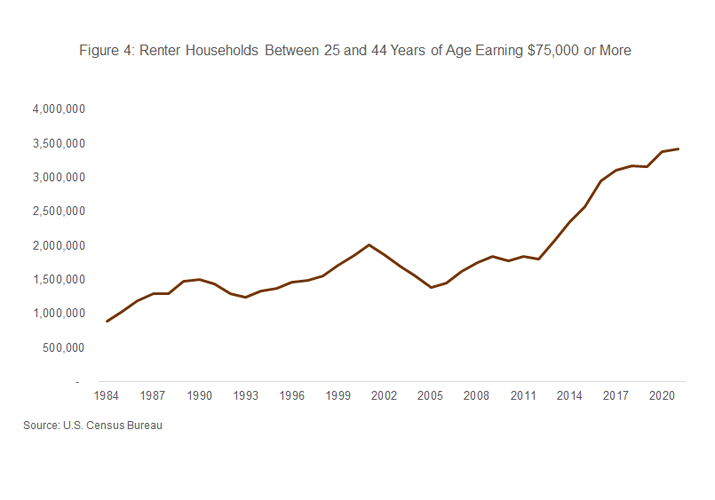First-Time Homebuyers are Driving the Market Forward

There were many factors behind the substantial increase in homebuying since the beginning of the pandemic, including record-low mortgage rates, shifting homebuyer preferences towards larger living spaces, increased remote work opportunities, migration to more affordable exurban suburbs or cities, and greater investor activity in the single-family market.
However, one overlooked factor dwarfs them all — the rise in first-time homebuyer purchases1. Our key takeaways about first-time homebuyers:
- First-time homebuyers are the major driver of the increase in demand. In 2021, Freddie Mac financed 554,000 loans for first-time homebuyers — up 22% from 2020. That’s the highest level since tracking began in 1994.
- While the rise in mortgage rates has caused affordability to deteriorate in the last few months, first-time homebuyer activity as of March has held up more than repeat buyers in this uprate cycle.
- The reason behind the higher demand is simple — it is all about demographics. The large cohort of Millennials that first entered the job market in the mid-2000s is now in their early-to-mid-30s — the typical age range of first-time homebuyers.
- Furthermore, the number of higher-income young renters has nearly doubled over the past ten years, so there remains a large reservoir of untapped potential first-time homebuyer demand.
Booming First-Time Homebuyer Activity
In 2016, 1.9 million first-time homebuyers obtained a mortgage to purchase a home, representing almost a third of the 6.0 million homes sold that year.2 Just four years later, in 2020, the number of first-time homebuyers obtaining a mortgage to purchase a home rose 26% to 2.4 million, while overall home sales rose only 8% to 6.5 million. These numbers make it clear: without the increase in first-time home purchases, home sales would have remained flat.
First-time homebuyer activity continued to increase last year, according to Freddie Mac mortgage data. In 2021, Freddie Mac financed 554,000 loans for first-time homebuyers — the highest level since tracking began in 1994 and up 22% from 455,000 in 2020 (Figure 1).3 Over the last 10 years, the first-time homebuyer’s share of Freddie Mac’s purchases rose from 36% in 2011 to 46% in 2021.
Year-to-date mortgage rates have increased two percentage points, the most since 1980, but Freddie Mac’s first-time homebuyer share is only down -1 percent from a year ago for Q1 2022 versus a -8 percent decline for repeat homebuyers. While the increase in mortgage rates has had an impact on overall purchase activity, it’s been less impactful on first-time homebuyers. Clearly, first-time buyers have not only been behind the rise in purchase activity prior to this year, but so far first-time homebuyers are serving as a purchase market buffer against the rising tide of mortgage rates.
Drivers of First-Time Homebuyer Demand
The rise in first-time homebuyers over the last few years is due to several drivers. The primary driver is the initial wave of 25- to 34-year-olds entering the workforce in the mid-2000s (Figure 2). At the start of the 2000s, the number of 25- to 34-year-olds was still declining due to the smaller cohort of the Generation X demographic that came after the much larger Baby Boomer generation. In late 2007, the Great Recession began, causing a considerable delay in employment and homeownership opportunities for several years. The 25- to 34-year-old demographic regained its footing in the early-to-mid 2010s and began a decade-long increase in employment, resulting in an increase in first-time homebuyers that continues into 2022.
Another driver of the recent surge in first-time homebuyers was delayed homebuying activity by prime-age households. Homeownership rates among 25- to 44-year-olds with incomes of $75,000 or more were between the low and mid-80s for three decades, before declining to the low 70s after the Great Recession (Figure 3). With incomes above the median, these households should have been able to afford homes in most cities. Yet their homeownership rate fell nine percentage points relative to the last 35 years and still has a long way to go to recover.
This decline in homeownership rates is due to a variety of factors beyond the long-lasting impacts of the Great Recession and the wave of foreclosures on homeowners who purchased in the early 2000s. Notable factors include longer-term income stagnation, increased automobile and student loan debt, delayed marriage, and declining birth rates. The combination of these factors made it more difficult for renters to save for a down payment, delaying their transition into homeownership.
While some of these challenges remain, the number of 25- to 44-year-old renters with earnings of $75,000 or more has been on the rise in the last few years due to the strong labor market (Figure 4). This reflects a large and increasing reserve of renters with sufficient income to purchase their first home. Moreover, the decline in mortgage rates in 2019 to record low levels in 2021 provided many who had delayed purchasing their first home with an opportunity to jump into the market. The combination of pent-up demand and low-interest rates, along with hitting milestones like marriage and children, led more and more of these borrowers to pursue homeownership.
Obstacles for First-Time Homebuyers
While first-time homebuyer demand is driving the market forward, the lack of supply of affordable entry-level homes remains a significant obstacle. We have written extensively on the overall supply shortage for the housing market. Our latest research on this topic highlighted that new construction of entry-level homes (defined as single-family units smaller than 1,400 square feet) declined from over 400,000 new units in the 1970s to less than 100,000 during the 2010s. The supply of larger and higher-priced new homes has improved but the number of new entry-level homes is still lacking.
Additionally, the lack of supply of new affordable entry-level homes is impacting first-time homebuyers’ preference between new and existing homes. Since emerging from the Great Recession, of the first-time homebuyers Freddie Mac helped to purchase a home, only 11% purchased new homes and prior to the Great Recession, 21% of such homebuyers purchased new homes. These percentages are well below the levels in the 1990s and mid-2000s before the Great Recession.
The decline in the number of first-time homebuyers purchasing new homes clearly reflects a shift toward existing homes, which are generally more affordable. Existing homes typically sell for about 25% less than new homes and the significant rise in home prices has pushed the already more expensive new homes out of reach for most first-time homebuyers. This has forced a large wave of first-time homebuyers to compete against other buyers for a limited inventory of existing homes. This is consistent with our research that shows that the existing home inventory is increasingly occupied by higher-income households.4 The result is an insufficient supply of affordable existing homes to meet the rising demand from first-time homebuyers.
A more recent obstacle to first-time homebuyers is rising mortgage rates, which further decrease housing affordability. These obstacles could cause further shifts in homebuyer preferences, such as the increase in demand for homes in locations more affordable than city centers, such as suburbs, rural areas, or less expensive metro areas.
Concluding Thoughts
There has been much talk asserting that strong home sales in recent years were driven by low mortgage rates and increased demand since the beginning of the pandemic. While that is part of the story, a more important and fundamental force is a large demographic wave resulting in more first-time homebuyers. A large cohort of Millennials has now reached their early- to mid-30s – the typical age range of first-time homebuyers. They have been a major driver of demand since the mid-2010s.
There is also a large and increasing pipeline of renters between 25- and 44-years-of-age who have sufficient income to purchase their first homes. While this large demographic of young professionals provides fertile conditions for the first-time homebuyer market to continue to grow, there are major headwinds. First, the shortfall in the construction of affordable entry-level homes remains a significant issue. Second, we are concerned that the market over the last decade has become more sensitive to increases in mortgage rates. If mortgage rates continue to increase at a swift rate, it would lead to further deterioration in affordability and limit opportunities for many potential first-time homebuyers.
Freddie Mac will continue to monitor and report on first-time homebuyer activity and the impacts on the housing market. As part of our mission, we remain committed to supporting home purchases for this important segment of the market.
References
1 According to HUD, first-time homebuyer is defined as an individual who has not had an ownership in a primary residence during the 3-year period prior to the purchase of a property.
2 According to FHFA’s National Mortgage Database, homes may be purchased with cash or through mortgage financing.
3 Freddie Mac’s business is subject to a variety of factors, such as changes in underwriting, competitive landscape, and shifting market structure, which can affect the level of Freddie Mac’s purchases of mortgages for first-time homebuyers compared to the market in some years. While the increase in Freddie Mac’s purchases of mortgages for first-time homebuyers is larger than the overall market’s for the years prior to 2020, the trends are similar.
4 Liu, Liyi and McManus, Douglas A. and Yannopoulos, Elias, Geographic and Temporal Variation in Housing Filtering Rates (November 16, 2021). Available at SSRN: https://ssrn.com/abstract=3527800 or http://dx.doi.org/10.2139/ssrn.3527800.
©2025 by Freddie Mac.



